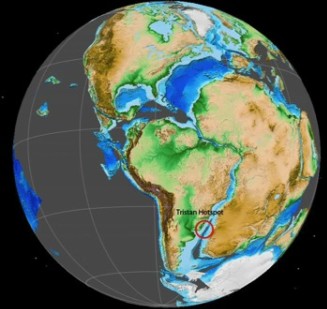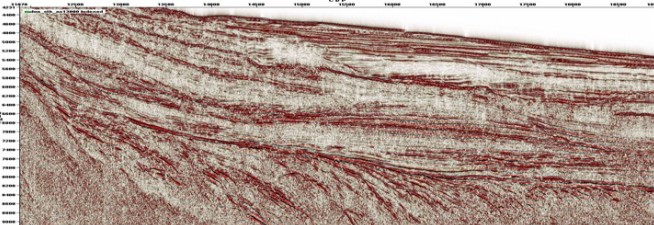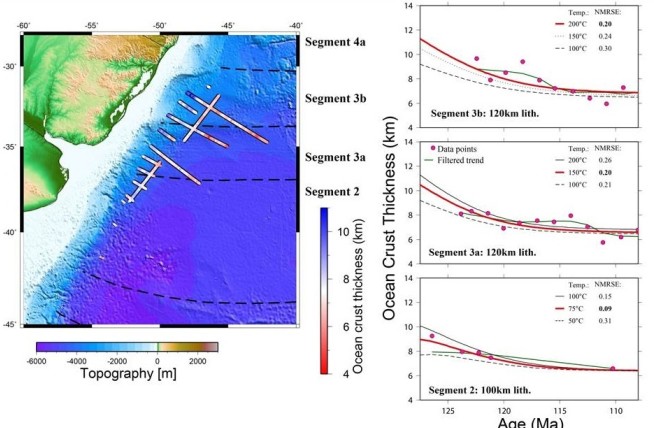Magmatism and Continental Breakup in the South Atlantic

The southern South Atlantic has often been considered a classic example of continental break-up in the presence of a starting mantle plume (Fig.1). Evidence for a mantle plume includes the onshore Paranà-Etendeka continental flood basalts, which are associated with the offshore Rio Grande Rise and Walvis Ridge, and the wide-spread presence of seaward dipping reflectors and high-velocity lower-crustal bodies along the rifted conjugate margins.
This project aims to test the predictions of melt volumes and seismic velocity from our numerical models against an oil-industry seismic reflection dataset from the South Atlantic provided by ION-GXT. The 2D seismic lines are spectacular- routinely imaging to beneath the Moho allowing insight into the deep structure of the continental margins. Volcanic rocks, including seaward dipping reflectors (SDRs, Fig.2) and lower-crustal bodies are routinely imaged on these data.


As part of this project we measured the thickness of the earliest oceanic crust generated along the length of the South Atlantic south of the Rio-Grande Fracture Zone from wide-angle and multichannel seismic profiles collected along the conjugate margins. These measurements show that at 450 km south of the Paranà-Etendeka flood basalts the oceanic crust is 11.7 km thick (the global average is just 6-7 km). Farther south the oceanic crust thins, reaching 6.1. km at a distance of 2300 km along-strike. Overall, the along-strike trend of oceanic crustal thickness is linear with a regression coefficient of 0.7. We also documented the thinning of the oceanic crust as seafloor spreading continued after breakup (Fig.3). From numerical models representing extension of the lithosphere, we find that observed melt volumes are matched with the presence of a hot layer. If we assume this region of hot mantle has a thickness of 100 km, its excess temperature relative to the asthenosphere has to decrease from 200 to 500C north (offshore southern Brazil) to south (offshore central Argentina). This decrease in temperature, also seen in published thermobarometry results, suggests that temperature was the primary control of volcanism during the opening of the southern South Atlantic.
Publications
McDermott C, Collier JS, Lonergan L, et al., 2019, Seismic velocity structure of seaward-dipping reflectors on the South American continental margin, Earth and Planetary Science Letters, Vol: 521, Pages: 14-24, ISSN: 0012-821X
McDermott C, Lonergan L, Collier JC, et al., 2018, Characterization of seaward-dipping reflectors along the S. American Atlantic margin and implications for continental breakup, Tectonics, Vol: 37, Pages: 3303-3327, ISSN: 0278-7407
Armitage, J. J. and J. S. Collier, 2017, The thermal structure of volcanic passive margins, Petroleum Geoscience. 10.1144/petgeo2016-101
Collier JS, McDermott C, Warner G, , 2017, New constraints on the age and style of continental breakup in the South Atlantic from magnetic anomaly data, Earth and Planetary Science Letters, Vol: 477, Pages: 27-40
Taposeea CA, Armitage JJ, Collier JS, 2016, Asthenosphere and lithosphere structure controls on early onset oceanic crust production in the southern South Atlantic, Tectonophysics, Vol: 716, Pages: 4-20
See also
People
- Jenny Collier
- Lidia Lonergan
- Gareth Roberts
- John Armitage (IGP, Paris)
- Zofia Zalai (PhD student)
- Carl McDermott (PhD student, graduated)
- Chandra Taposeea (PhD student, graduated)
- George Warner (MSci student, graduated)
- Naomi Gyori (UROP student, graduated)